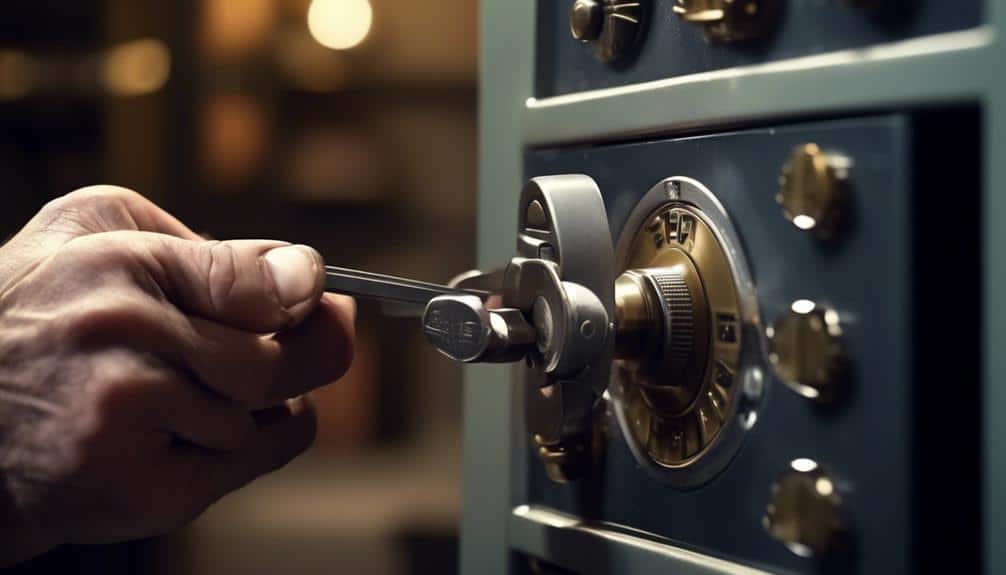When it comes to the intricate world of commercial safes, there are a multitude of efficient techniques that exist for opening them. However, what you may not know is that these techniques are not just limited to the realm of professional locksmiths.
In fact, with the right knowledge and tools, anyone can learn how to crack open a commercial safe. In this discussion, we will uncover six valuable tips that will help you navigate this complex task with precision and finesse.
So, whether you're a curious individual looking to expand your knowledge or a professional seeking to enhance your skills, these tips will provide you with the essential guidance you need to master the art of opening commercial safes.
Assessing the Safe's Security Features

To assess the security features of a commercial safe, we carefully examine its construction, locking mechanism, and resistance to common burglary techniques. One crucial aspect of modern safes is biometric authentication, which provides an added layer of security. Biometric authentication utilizes unique physical characteristics, such as fingerprints or iris patterns, to verify the identity of the user. This technology ensures that only authorized individuals can access the safe's contents. However, even with biometric authentication, it's essential to consider the vulnerability of the electronic keypad.
Electronic keypads are commonly used in commercial safes to provide quick and convenient access. However, they can also be susceptible to certain vulnerabilities. For example, hackers may attempt to bypass the system by exploiting weak passwords or using brute force attacks. It's crucial to choose a safe that has robust security measures in place, such as password complexity requirements or lockout features after multiple incorrect attempts.
Additionally, electronic keypads can be prone to wear and tear over time, potentially leading to malfunction or failure. Regular maintenance and inspection of the keypad are essential to ensure its proper functioning and prevent any unauthorized access due to technical issues.
Identifying the Right Tools for the Job

We carefully consider the appropriate tools needed for the task at hand when identifying the right tools for opening commercial safes. Safe cracking tools and safe opening techniques are essential for successfully gaining access to a locked safe.
One of the most common tools used in safe cracking is a drill. A high-quality drill with various drill bits is necessary to create a hole in the safe, allowing us to manipulate the lock mechanism.
Additionally, we rely on specialized tools such as dial indicators, which help us determine the combination by measuring slight variations in the dial's resistance. These indicators are crucial in accurately deciphering the safe's code.
Another tool that we often use is a stethoscope. By listening to the internal workings of the safe's lock, we can detect the subtle clicks and movements that indicate the correct combination.
Finally, we utilize safe opening techniques such as manipulation, which involves manipulating the lock's components using specialized tools. This technique requires precision and expertise to avoid damaging the safe or lock mechanism.
Understanding Safe Manipulation Techniques

Safe manipulation techniques involve precise and expert manipulation of the lock's components to gain access to a locked safe. Understanding these techniques is crucial for any professional locksmith or safe technician. Here are three key aspects to consider when it comes to safe manipulation:
- Safe Cracking Methods: Safe cracking refers to the process of bypassing the security measures of a safe to gain unauthorized access. There are various safe cracking methods, including drilling, bouncing, and manipulation. Each method requires a different skill set and level of expertise.
- Combination Lock Manipulation: Combination lock manipulation is a technique used to determine the correct combination of a lock without using force or damaging the lock. This method involves carefully listening and feeling for subtle changes in the lock's internal mechanism as the dial is turned. Skilled technicians can detect the proper combination through these minute movements and successfully open the safe.
- Precision and Patience: Successful safe manipulation requires a high level of precision and patience. It's essential to have a deep understanding of the lock's mechanism and the ability to manipulate it accurately. Technicians must be patient and persistent, as safe manipulation can be a time-consuming process that requires meticulous attention to detail.
Utilizing Advanced Lock Picking Methods

Now let's talk about utilizing advanced lock picking methods.
When it comes to expert lock picking techniques, we've a range of tools and methods at our disposal. These advanced techniques allow us to bypass even the most sophisticated locks, ensuring that we can open commercial safes efficiently and effectively.
Expert Lock Picking Techniques
Utilizing advanced lock picking methods, experienced locksmiths employ expert techniques to open commercial safes. These techniques are designed to bypass advanced lock systems while ensuring non-destructive entry methods. Here are three key strategies that locksmiths use to effectively open commercial safes:
- Lock Decoding: Locksmiths use specialized tools and knowledge to decode the intricate mechanisms of the lock. By understanding the inner workings of the lock, they can manipulate the components to unlock it without causing any damage.
- Lock Impressioning: This technique involves creating a replica of the key through carefully manipulating the lock. Locksmiths use specially designed tools to make impressions of the lock's pins and tumblers. With this information, they can then create a working key to unlock the safe.
- Lock Manipulation: By skillfully manipulating the lock's internal components, locksmiths can decipher the combination or code required to open the safe. This technique involves a deep understanding of lock mechanisms and requires precision and finesse.
With these expert lock picking techniques, locksmiths can successfully access commercial safes without causing any unnecessary damage.
Advanced Tools and Methods
After gaining a deep understanding of lock mechanisms and employing expert lock picking techniques, locksmiths can further enhance their abilities by utilizing advanced tools and methods to open commercial safes. These advanced bypassing techniques and tools are designed to exploit the vulnerabilities in electronic locks commonly used in commercial safes. By identifying and exploiting these vulnerabilities, locksmiths can gain quick and efficient access to locked safes. Some of the advanced tools and methods used include:
| Advanced Tools | Methods | Benefits |
|---|---|---|
| Electric lock pick | Decoding | Quick access |
| Auto-jigglers | Manipulation | Minimal damage |
| Lock bypass tools | Impressioning | No trace of tampering |
| Tubular lock picks | Bumping | Non-destructive |
These advanced tools and methods require skill and expertise to use effectively. Locksmiths who have mastered these techniques can provide efficient and reliable commercial safe opening services.
Exploring Safe Drilling and Cutting Approaches

We can explore various approaches to drilling and cutting commercial safes for safe opening. When it comes to opening a safe, drilling and cutting are often considered as last resorts. However, in certain situations where safe bypassing techniques and alternative entry methods have failed, drilling and cutting may be the only option left.
Here are three important considerations when it comes to drilling and cutting commercial safes:
- Precision and Accuracy: Drilling and cutting should be done with extreme precision and accuracy to minimize damage to the safe and its contents. It's crucial to have a skilled technician who understands the inner workings of the safe and can carefully execute the drilling or cutting process.
- Proper Tools and Equipment: Using the right tools and equipment is essential for successful drilling and cutting. Specialized drills, diamond-tipped bits, and cutting torches are commonly used in these techniques. It's important to ensure that the tools are in good working condition and suitable for the specific type of safe being opened.
- Safety Precautions: Drilling and cutting commercial safes can be dangerous, and safety precautions must be taken. Protective gear, such as goggles, gloves, and masks, should be worn to protect against potential hazards. Additionally, proper ventilation and fire safety measures should be in place to prevent accidents.
Ensuring Safe and Damage-Free Access

When ensuring safe and damage-free access to commercial safes, it is crucial to prioritize the careful execution of drilling and cutting techniques, minimizing any potential harm to the safe and its contents. To achieve this, there are several key strategies that can be employed to minimize time and effort while maintaining confidentiality and privacy.
Firstly, it is essential to use high-quality tools and equipment specifically designed for safe opening. This ensures precision and reduces the risk of unnecessary damage. Additionally, practicing proper drilling techniques, such as using the correct drill bit size and speed, can significantly minimize the time required to open the safe.
Moreover, employing advanced technology can further enhance the efficiency and safety of the process. For instance, utilizing electronic lock bypass tools can eliminate the need for drilling altogether, reducing the risk of damage and preserving the confidentiality of the safe's contents.
To emphasize the importance of these strategies, here is a table showcasing the benefits of utilizing proper techniques:
| Key Strategies | Benefits |
|---|---|
| Using specialized tools | Minimizes risk of damage |
| Practicing proper drilling techniques | Reduces opening time |
| Utilizing electronic lock bypass tools | Preserves confidentiality and privacy |
Frequently Asked Questions
Are There Any Legal Restrictions or Regulations Surrounding the Use of These Techniques for Opening Commercial Safes?
There may be legal implications and ethical considerations surrounding the use of techniques for opening commercial safes.
It's important to be aware of any legal restrictions or regulations that may govern these methods.
Additionally, it's crucial to consider the ethical implications of using such techniques, as they may infringe upon the rights and privacy of others.
Before employing any techniques, it's advisable to consult legal professionals and ensure compliance with applicable laws and ethical standards.
Can These Techniques Be Used on All Types of Commercial Safes, Regardless of Their Size or Brand?
Can these techniques be used on all types of commercial safes, regardless of their size or brand?
Well, when it comes to size limitations, it's important to note that these techniques may not be suitable for extremely large safes, as they require a certain level of precision and finesse.
As for brand-specific challenges, different manufacturers may have unique mechanisms and security features that can make opening their safes more difficult.
However, with the right knowledge and experience, these techniques can be adapted to various sizes and brands.
What Are the Potential Risks or Dangers Involved in Attempting to Open a Commercial Safe Without Professional Assistance?
Attempting to open a commercial safe without professional assistance can pose significant risks and potential dangers. Without the proper knowledge and tools, there's a high chance of causing damage to the safe or its contents. Additionally, there's a risk of injury due to mishandling of tools or accidents during the opening process.
It's always recommended to seek professional help to ensure the safe is opened safely and without any negative consequences.
Can These Techniques Be Used to Open a Commercial Safe Without Leaving Any Evidence of Tampering?
When it comes to opening commercial safes, we've learned a thing or two. And let me tell you, these techniques we've discovered are like a silent ninja in the night – they leave no trace behind.
Non-destructive methods have proven to be effective in opening commercial safes without leaving any evidence of tampering. So rest assured, with the right techniques, you can crack that safe without anyone ever knowing.
Is It Possible to Re-Lock a Commercial Safe After It Has Been Opened Using These Techniques, in Order to Maintain Security?
Re-locking mechanisms are essential for maintaining security after opening a commercial safe using these techniques.
To ensure the utmost security, several measures can be taken.
For instance, high-quality re-locking mechanisms can be installed to prevent unauthorized access.
Additionally, tamper-evident seals can be used to indicate any attempts at tampering.
Regular audits and inspections should also be conducted to detect any signs of compromise.


